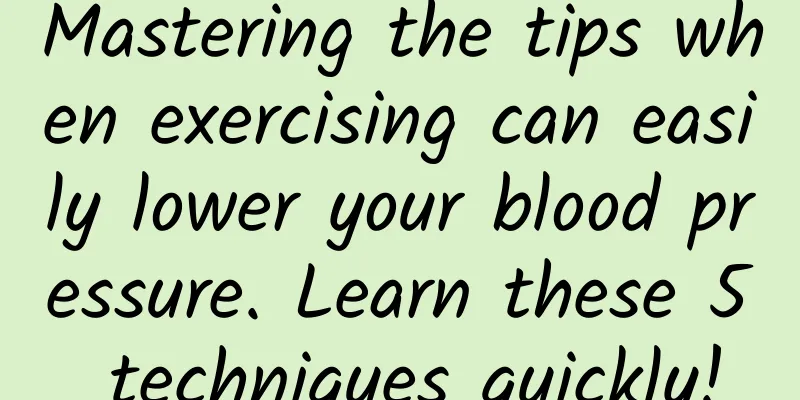Mastering the tips when exercising can easily lower your blood pressure. Learn these 5 techniques quickly!

|
High blood pressure is like a slow knife, lurking in the human body, quietly damaging blood vessels and body organs. It may seem fine at ordinary times, but once it suddenly breaks out, it can cause critical illnesses such as myocardial infarction and stroke, which can kill people in minutes. Data show that about 70% of stroke deaths and about 50% of myocardial infarctions in my country are closely related to hypertension. If blood pressure can be lowered, the incidence of stroke can be reduced by 35% to 40%. How to lower blood pressure? When blood pressure is too high, you need to take antihypertensive drugs for life. In addition, patients with hypertension should maintain healthy and regular eating habits and exercise appropriately. There is no need to say much about diet, but I still need to talk more about exercise. Regular exercise can improve cardiopulmonary endurance, increase vascular elasticity, regulate autonomic nerves, reduce weight, and thus lower blood pressure. Brisk walking or jogging is most practical The first choice of exercise is medium to low intensity aerobic exercise, including brisk walking, jogging, slow cycling, slow swimming, yoga, group exercises, etc. However, brisk walking and jogging are still practical, after all, you can move whenever you want. Exercise should be suitable There are many types of aerobic exercise. You can choose the exercise method that suits you according to your actual situation, such as age, weight, health status, disease control level, previous exercise habits and physical condition, etc. The amount of exercise varies from person to person Too little exercise will not work, and too much exercise will make you feel exhausted. Generally speaking, 30 minutes of aerobic exercise every day is a relatively reasonable amount of exercise, or you can find the amount of exercise that suits you based on your own feelings. Before exercising, it is best to warm up for 5 to 10 minutes. When exercising formally, the appropriate intensity is: you can talk effortlessly while exercising, but you can't sing, and you sweat slightly. You can maintain this intensity for 20 to 30 minutes. The key to exercise is persistence Maintaining ideal blood pressure is a long-term process. If exercise is always intermittent, the effect may not be ideal. Therefore, don't be greedy and do it too fast at the beginning. Choose your favorite and easiest exercise and do it slowly. Be persistent and develop long-term and regular exercise habits. Avoid morning exercise Blood pressure fluctuates 24 hours a day. Most people have dipper-type blood pressure. The blood pressure rhythm throughout the day shows "two peaks and one valley": blood pressure starts to rise between 6 and 10 a.m. and 4 to 8 p.m., especially in the morning, so try to avoid exercise during these two time periods. Vigorous exercise For example, fast climbing, mountain climbing, and fast running are not suitable for people with high blood pressure because strenuous exercise can cause huge fluctuations in blood pressure, which may seriously damage blood vessels and cause corresponding complications. Breath-holding exercise For example, push-ups, sit-ups, pull-ups, etc., these exercises require holding your breath and contracting the muscles of the head and neck, which will cause a transient increase in blood pressure. Stop drinking Alcohol can irritate the gastric mucosa, which may cause erosion and ulcers of the gastric mucosa. In severe cases, serious complications such as gastrointestinal bleeding may occur. Frequent changes of body position and prolonged head-down movements Hypertensive patients have poor cardiovascular reflex function and are prone to orthostatic hypotension, which means they may feel dizzy, blackout, or even faint when they suddenly stand up or change position after squatting or lying down for a long time. Therefore, this type of exercise is not suitable for them. When blood pressure is not well controlled When your blood pressure is unstable, you should never exercise, as this will aggravate blood pressure fluctuations. When the primary disease is not under control Patients with secondary hypertension should avoid exercise if the primary disease is not well controlled and serious complications occur, such as obvious arrhythmia, unstable angina and cerebral vasospasm. Feeling unwell If you feel chest pain or tightness, dizziness, arm or jaw pain, obvious shortness of breath, irregular heartbeat, or excessive fatigue during exercise, you must stop exercising immediately. Do not try to be tough, and remember to go to the hospital for a check-up. Finally, I would like to remind everyone that hypertension is a disease that requires comprehensive prevention and treatment. In addition to regular exercise, you should also pay attention to the balance of dietary nutrition and combine it with necessary drug treatment to be a long-term solution. Source: Youlai Healthy Life |
Recommend
What should we think about when e-sports enters other people’s classrooms?
Recently, foreign media reported that a public hi...
Cook’s iPhone moment has not come yet!
Click to participate in the 51CTO website content...
Experience in optimizing game performance
[[149217]] Introduction to Optimization When it c...
If your weight reaches this number, your brain may age 12 years earlier?
A recent study claims that a certain weight is eq...
C4D Zero-Based Introductory Course for Newbies 2021
Resource Introduction of C4D Zero-Base Introductor...
The 8 most anticipated tech products of 2016
In 2015, many eye-catching products were launched...
Lu Heping Channel Development and Dealer Management
Teach you to build a channel model that integrate...
How much does it cost to make a Tongliao home furnishing mini program? What is the quotation for making Tongliao home furnishing mini program?
There is no doubt that the topic of mini programs...
Interesting fact: Why can’t humans synthesize vitamins?
Anyone who knows a little about biology knows tha...
Case Analysis: How does Kugou increase its user base?
This is the fifth article I have written about gr...
K12 online education activity operation sop!
Breaking down the basic meaning of referral and t...
WeChat Mini Program Mall Ranking, What Are the Factors Affecting Mini Program Ranking?
Open the APP on your phone, no matter which e-com...
Hunter Camp "Xiaohongshu Zero-Based Traffic and Money-Making Course"
The main focus of this course is to explain how t...
Nezha's fire + Ao Bing's ice = steam explosion?
Review expert: Zhou Hongzhi, senior experimenter ...
More than 5,000 years ago, they lived in "three bedrooms and one living room"
On the banks of the great river, there are relics...









